
The Roman Empire was very large. It included many lands and all the people of these lands wore different styles of clothing. In Egypt, for example, the people wore simple tunics and see-through dresses.

The Celtic people wore long, woolen shawls, and trousers. But what did the people who lived in the capital city of Rome wear?

Ancient Romans must have liked comfortable clothes. We can guess this because the most popular piece of clothing was the tunic. A tunic was a simple, loose-fitting garment. It looked kind of like a long, sleeveless T-shirt. Men’s tunics were knee-length. Women’s tunics were ankle-length. Tunics were usually white and made of linen. Rich and poor people wore tunics. But if you were rich, you wore other layers of clothing. Rich Roman women wore a long dress called a stola over their tunics. They also wore a shawl called a palla. Rich men wore togas over their tunics. A toga was a long, dress-like wrap. Wealthy men and boys were expected to wear togas in public. Once at home, though, they probably took them off. Togas were made of wool, so they were hot and uncomfortable to wear!
Colors were an important part of Roman fashion. Common or poor people dressed mainly in white clothes. This is because dyes could be expensive. The rich liked to wear bright colors. Women from wealthy and powerful families wore clothing dyed with shades of red, yellow, orange, and blue. Dressmakers made colored cloth using plant dyes. Roots of the madder plant were used for red. Leaves of an herb called woad were used for blue. The crocus plant made yellow.
A man from a wealthy and powerful family, such as a senator, would wear a toga with a purple edge. A young boy from a wealthy family would wear a thin band of purple on the edge of his toga. Once a boy turned 16 and was considered an adult, he wore a wider band of purple on his toga. The emperor wore a purple toga with a gold band on the edge. Purple dye

Roman women loved wearing makeup and having styled hair. They often had slaves whose only jobs were to apply makeup and style hair.
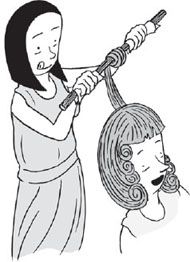
In ancient Rome, pale skin was considered fashionable because it showed that a woman didn’t need to spend time working in the sun. Before putting on red or pink rouge and green or blue eye shadow, Roman women applied white powder foundation to their skin. This powder was made from lead. It was poisonous, and some people believe it probably made women sick! Rouge and eye shadow were made from other minerals and plants.
Slave women wore their hair short, but free Roman women grew their hair long. For most of ancient Roman history, women’s hairstyles were simple. They usually just pulled their hair back into ponytails or buns.
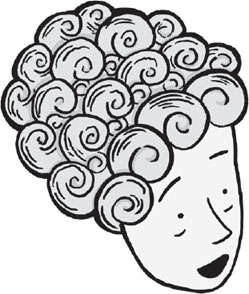
Later on, rich women began wearing curls. These curls were made with a hollow, heated rod of iron called a calamistrum. It was the first curling iron! Curls were kept in place with ribbons and hairpins made of bone and wood. Wigs were also popular. Many wigs were made with the blond hair of German women. Most ancient Roman women had dark hair. Blond hair was different and therefore considered special and very fashionable.

Ancient Roman men usually had short hair. For most of Roman history, they didn’t have beards or mustaches. Keeping their faces hairless was a tough thing, though. There were no razors or scissors, so barbers removed facial hair with tweezers. Ouch! But when Emperor Hadrian grew a beard to hide a scar on his chin, beards became the fashion. Kind of like how famous people start fashion trends today!
Both men and women wore rings. They were usually made of gold, silver, or bronze. Women also wore bracelets, earrings, and necklaces.
Men and women kept their clothes in place with a pin called a fibula. This was the Roman version of a safety pin. They also used brooches, decorative pins with a clasp, to keep clothes in place. Both men and women sometimes wore cameos. Cameos were small carvings, usually of a person’s profile.

| then: Romans wore mainly tunics, togas, and stolas made of wool or linen. Pants weren’t considered fashionable. | now: people who live in modern Rome wear lots of different clothes, including pants and jeans. |
A profile is the side view of someone’s face. Cameos were often carved out of coral and worn as rings or brooches.

All children wore a special locket-like necklace, called a bulla, that was given to them when they were born. Boys wore their bulla until they were considered men at age 16. After that, they were worn just for special occasions. Girls wore their bulla until they got married. Inside each bulla were amulets, or special charms, that the Romans believed gave the wearer protection. Bullas were usually made of leather. But rich children had bullas made of gold, silver, or bronze.

tunic: a simple, ancient Roman garment that looked like a long, sleeveless T-shirt. Both men and women wore tunics.
stola: a long dress worn by ancient Roman women.
palla: a rectangular, woolen shawl worn by women.
toga: a long, dress-like wrap worn by men.
senator: a government official in ancient Rome.
fibula: a special pin used by both men and women to hold their clothes in place.
bulla: a locket-like necklace given to each child at birth. There were amulets inside the bulla.
amulet: special charm that protects the wearer.
If you use a sewing machine for this project, you’ll need a grownup’s help.
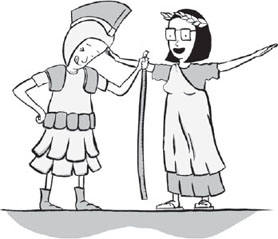
2 to 3 yards of lightweight material, such as an old sheet tape measure
scissors
fabric glue OR a sewing machine
fabric paint, beads, or other things to decorate your tunic
1 First, you have to figure out how much material you’ll need. Use the tape measure to measure from your shoulders to your knees (if you’re a boy) or to your ankles (if you’re a girl). Next, multiply that length by two.
2 Lay your material flat. Measure and cut your material to the length you need. Then fold it in half. Cut about 5 inches from one of the long sides. Save this strip of material. You can use it to make a sash. Don’t cut the fold or you’ll cut the sash in half.
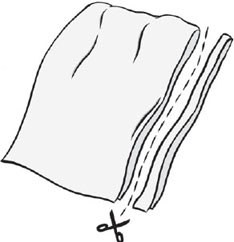
3 Cut a “T” shape out of your material. Then cut a small, half oval from the middle of the top, folded edge. This will be your neck hole.
4 Use the fabric glue to seal the sides of the body and the underside of each sleeve. You could use a sewing machine to sew a one-inch seam in these areas instead.
5 Turn the tunic inside out so the glue or seams don’t show.
6 Most Romans wore simple, white tunics. But, you can use the fabric paint and beads or sequins to decorate yours if you’d like. You can also use strips of material you cut in step 2 as a sash or belt.
7 When the fabric paint has dried, slip into the tunic and slip into history!
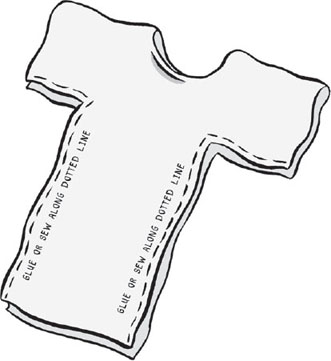

 Ancient Romans wore a variety of shoes. The most common type was a loose-fitting, leather sandal that looked kind of like a slipper. Poor people and farmers just wore strips of animal hide wrapped around their feet. Soldiers—who did a lot of walking—wore leather sandals or a leather boot with laces. To keep the soles of these shoes from wearing out too quickly, shoemakers put short nails, called hobnails, on them. Wearing hobnailed boots was a little like wearing soccer or baseball cleats.
Ancient Romans wore a variety of shoes. The most common type was a loose-fitting, leather sandal that looked kind of like a slipper. Poor people and farmers just wore strips of animal hide wrapped around their feet. Soldiers—who did a lot of walking—wore leather sandals or a leather boot with laces. To keep the soles of these shoes from wearing out too quickly, shoemakers put short nails, called hobnails, on them. Wearing hobnailed boots was a little like wearing soccer or baseball cleats.

A palla was a rectangular, woolen shawl that women in ancient Rome wore. They were usually brightly colored. To make one, all you need is 1½ yards of material. You can choose any color you’d like. Pallas were made of heavy material but you can use a lightweight material if you’d like. Just make sure the material you use drapes easily. Wrap the material around your shoulders like a shawl. To look more like a real ancient Roman woman, wear your tunic underneath. Let the extra material drape over your arms. Now, you’re stepping out in high, Roman fashion!

Q: What did the toga maker say when he was done making the toga?
A: That’s a wrap!
3 to 4 yards of white muslin*
scissors
purple fabric paint OR a purple marker (optional)
safety pins
* An old sheet that’s been cut in half won’t work quite as well, but it will do in a pinch. Plus, it’s a great way to recycle an old sheet!
1 Lay your material on the floor. Open it up if you haven’t already.
2 Cut the material into a half circle that is 4 feet long and about 4½ feet wide. The size of your half circle should depend on how tall you are. If you are tall, make it bigger. If you are short, make it smaller.
3 If you want a purple edge, now is the time to paint it on your toga. Let the paint dry before moving on. Remember: boys under the age of 16 had a thin, purple band around the edges of their togas.
To put your toga on:
Here is the easiest way to put your toga on: Use a safety pin to secure one end of the material near your waist. (You can wear your regular clothes or your tunic underneath.) Wrap the material around your waist at least once, then throw it over your left shoulder. Pull the material toward your waist and use a safety pin to keep it in place. You’ll probably need a friend or grown-up to help you with this part. You can rearrange the material to get it just the way you like.

You will be using spray paint and a hot glue gun for this project, so ask a grown-up to help.
heavy string
scissors
newspaper
brown, bronze, or gold spray-paint
1 small breath mint tin (not plastic), rectangular or circular, with a top
hot glue gun
sequins or permanent markers (optional)
good luck charm
1 Cut a piece of string long enough to fit over your head. Tie the two ends together.
2 Spread out newspaper to cover a large work area. Read the instructions on the can of spraypaint. Spray-paint the outside of the mint tin and the string. Let the paint dry.
3 Once the paint is dry, open the tin and spray-paint the unpainted areas. Turn the string over and paint the other side, too.
4 When the paint is dry, use the hot glue gun to attach the string to the back of the tin. The string should be near the edge of the tin, wherever you want the top of the bulla to be.

5 Decorate the outside of the bulla with sequins or markers, if you’d like.
6 Now you can put an amulet—a good luck charm—inside your bulla. Some ideas: a lucky penny or pebble, a rabbit’s foot, or a lucky rubber band.